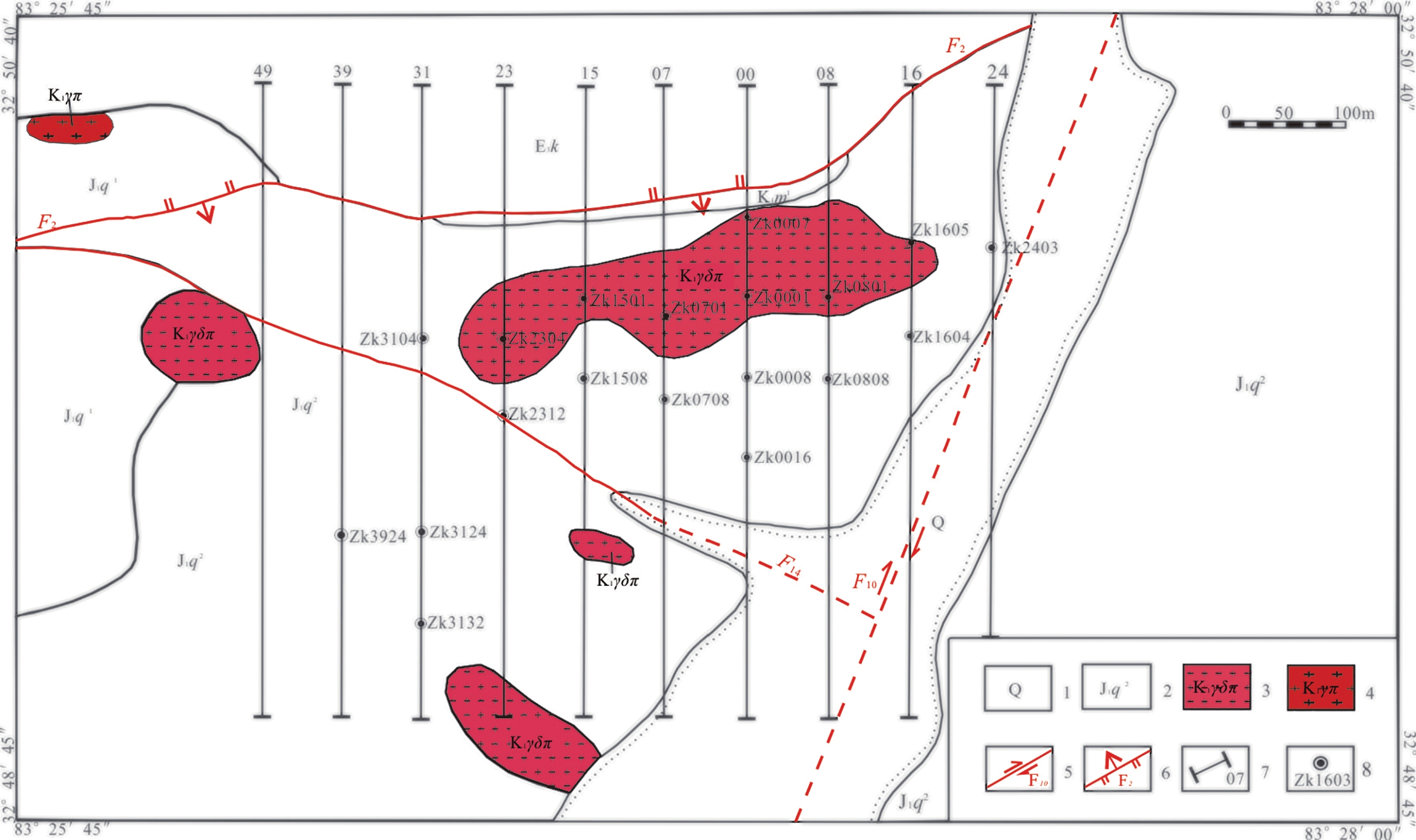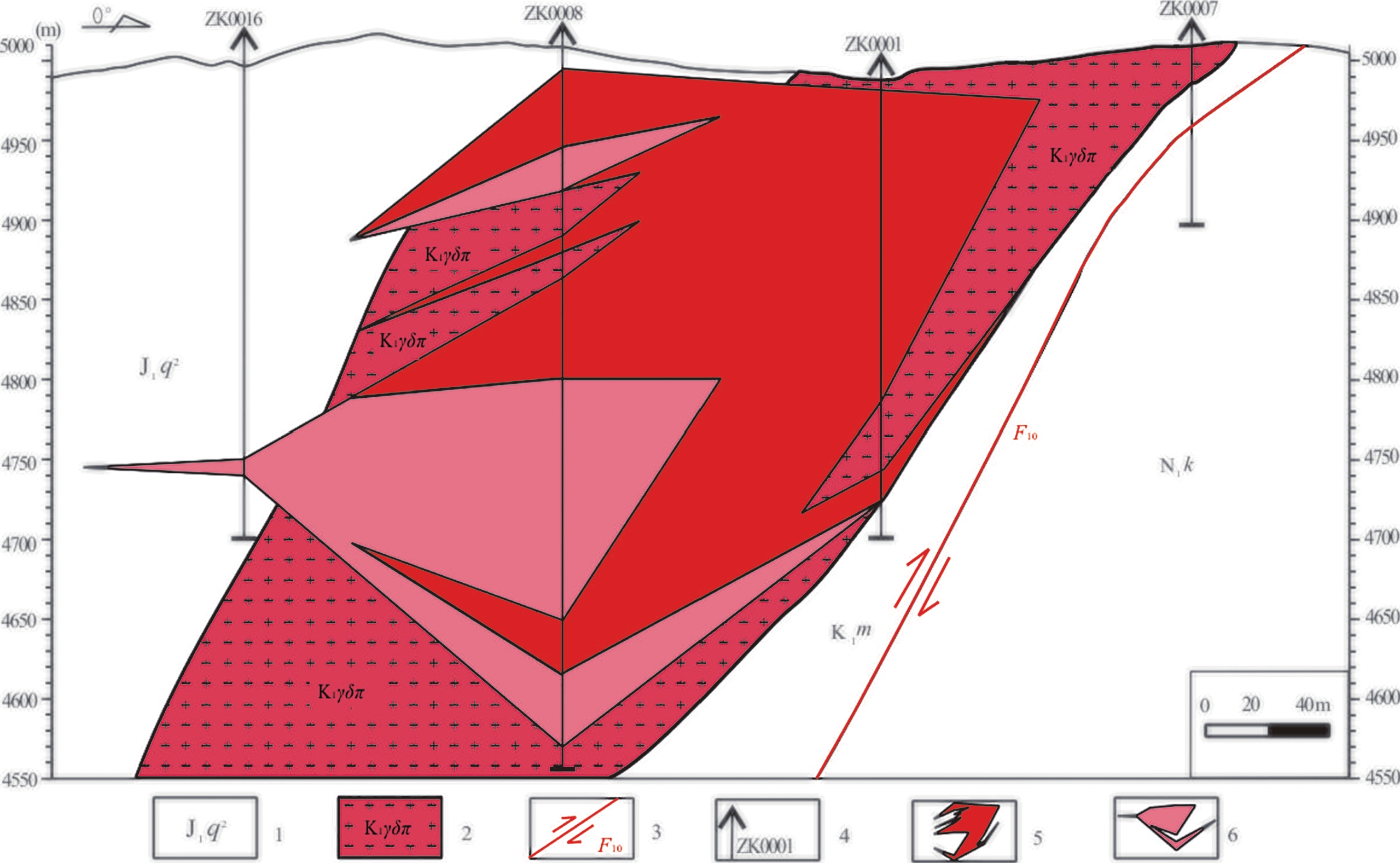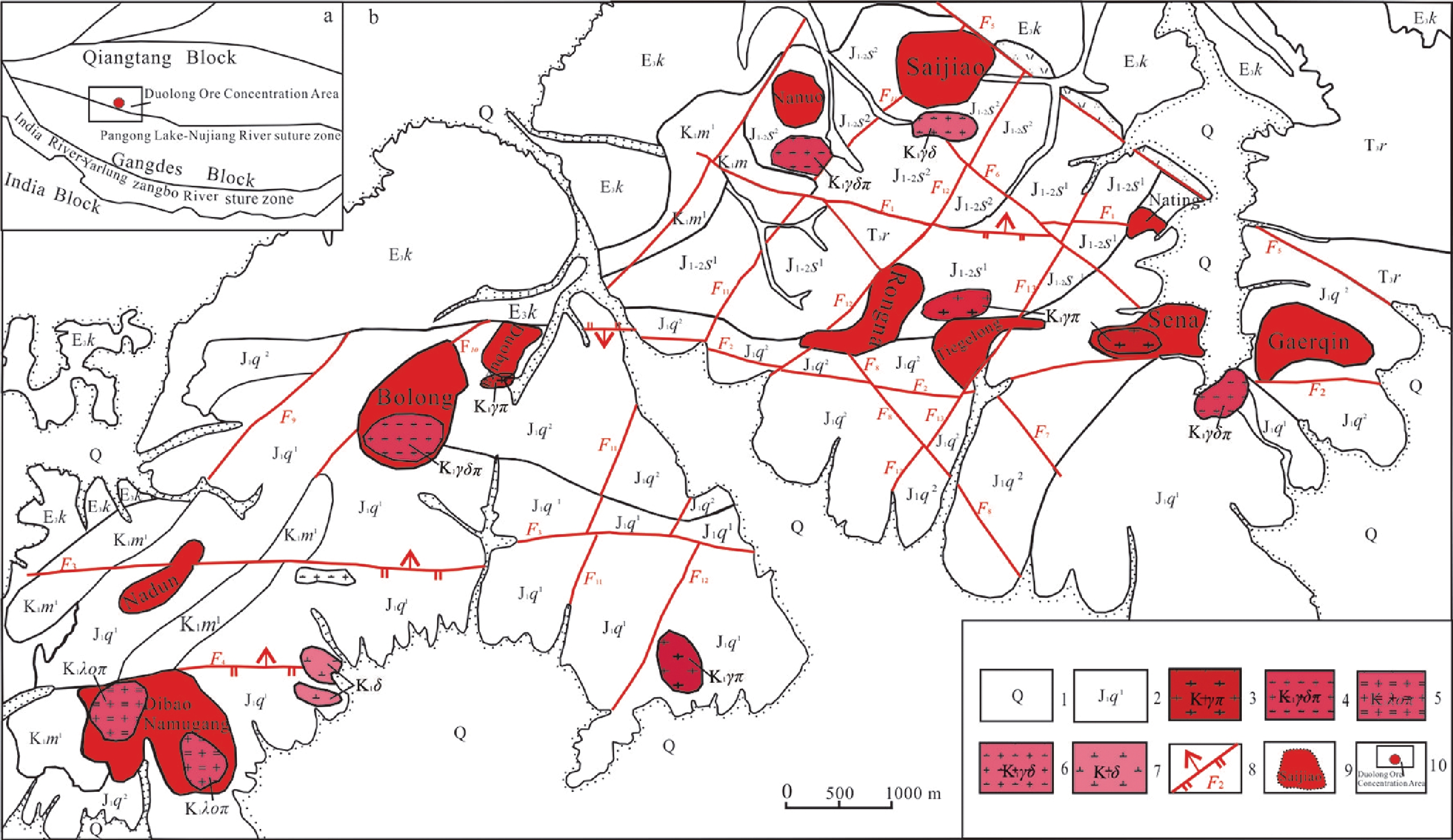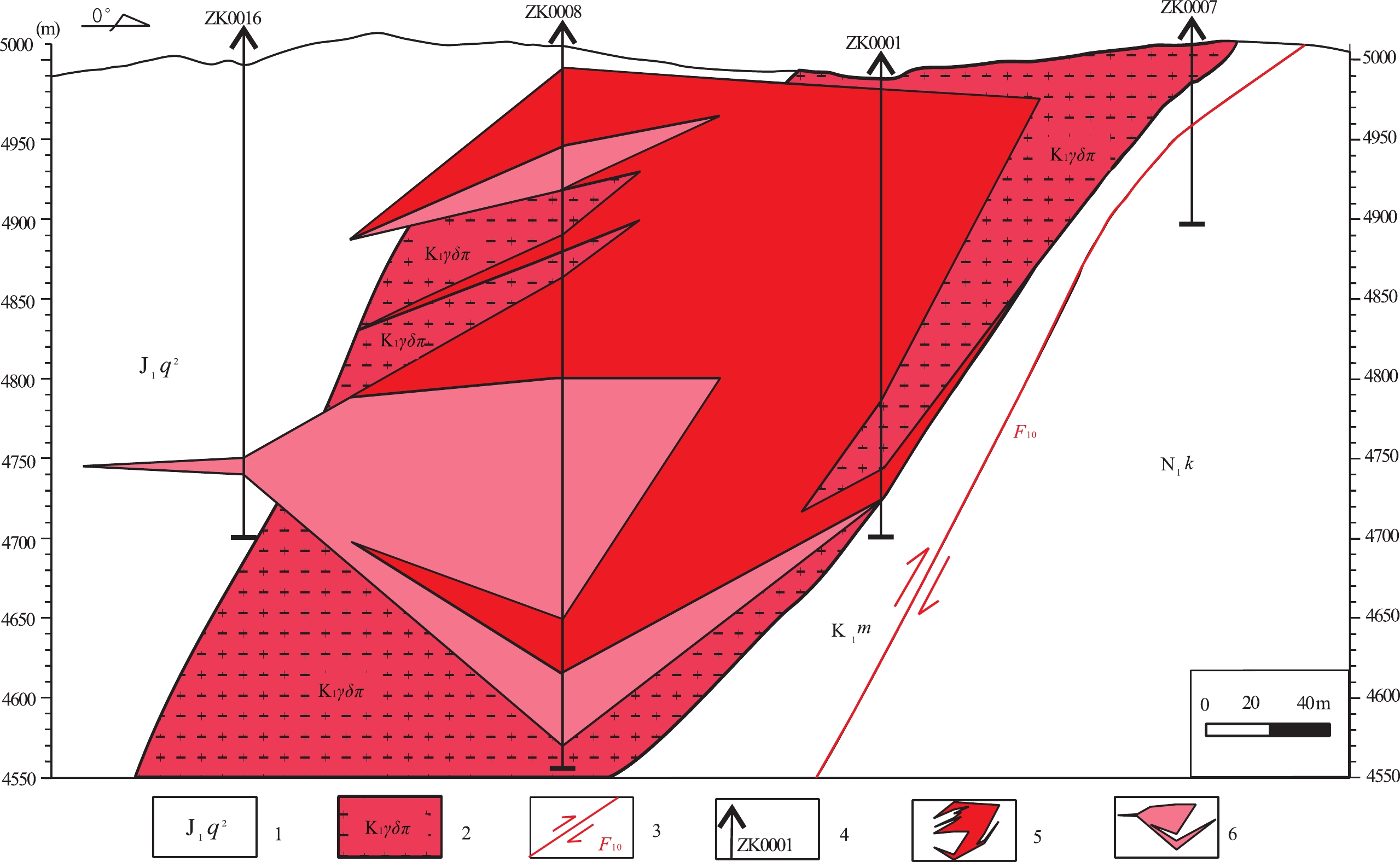-
摘要:
西藏多不杂铜矿是班公湖-怒江成矿带近年来发现的第一个大型斑岩铜矿床。该矿床位于班公湖-怒江缝合带北缘多不杂构造岩浆弧中,形成于早白垩世班公湖-怒江多岛弧-盆系演化时期,成矿年龄为120 Ma,成矿与侵位于早白垩统美日切错组地层中的石英闪长玢岩、花岗闪长斑岩有关。目前已探明铜、金资源量分别为230万吨,92吨,平均品位分别为0.51%、0.2 g/t,已达超大型矿床规模,是国家矿产资源战略储备基地。本数据集是在2005—2010年对该矿区矿产勘查所取得的宝贵数据基础上,开展的数据库建设的成果,采用10个数据表,重点汇集了多不杂铜矿单工程工业矿体和低品位矿体的品位数据及其计算结果,并对与储量计算有关的所有细节性数据做了系统性的归并整理。
Abstract:Duobuza Copper Deposit in Xizang, the first large-scale porphyry copper deposit discovered along Pangong Lake-Nujiang River metallogenic belt in recent years, is situated in Duobuza tectonic magmatic arc in the northern margin of Pangong Lake-Nujiang River suture zone. It was formed during the evolution period of archipelagic arc-basin system of Pangong Lake-Nujiang River of Early Cretaceous with metallogenic age of 120 Ma. The deposit is related to quartz diorite porphyrite and granodiorite-porphyry intrusions in the strata of Meiriqiecuo Formation of Early Cretaceous. Boasting of present measured resources of Cu and Au of 2.30 million tonnes and 92 tonnes with average grade of 0.51% and 0.2 g/t respectively, Duobuza Copper Deposit ranks as one of the super large-scale deposits and one of the national strategic reserve bases of mineral resources. The dataset of resource reserves in Duobuza Porphyry Copper Deposit of Xizang is built based on the valuable data obtained in the mineral survey during 2005-2010. It contains 10 data tables, in which the grades and relevant calculated results of single-engineering industrial ore bodies and low-grade ore bodies in Duobuza Copper Deposit are mainly included. Furthermore, all detailed data related to reserve calculation are summarized and collated systematically in the dataset.
-
Key words:
- Xizang /
- Duobuza Copper Deposit /
- Grade /
- Resource reserves /
- Dataset
-

-
图 1 多龙矿集区地质简图(据李玉彬等,2012)
图 3 多不杂矿区勘探线布置图(据李玉彬等,2012a)
图 1 Geological sketch of Duolong Ore Concentration Area (after Li YB et al., 2012)
表 1 数据库(集)元数据简表
条目 描述 数据库(集)名称 西藏多不杂斑岩铜矿资源储量数据集 数据库(集)作者 钟婉婷 成都理工大学,中国地质调查局成都地质调查中心
李玉彬 成都理工大学,西藏自治区地质矿产勘查开发局第五地质大队
李玉昌 西藏自治区地质矿产勘查开发局第五地质大队
刘超强 西藏自治区地质矿产勘查开发局第五地质大队
陈晓深 西藏自治区地质矿产勘查开发局第五地质大队数据时间范围 2005—2010年 地理区域 西藏改则县多不杂矿区 数据格式 *.docx 数据量 9.54 Mb 数据服务系统网址 http://dcc.cgs.gov.cn 基金项目 中国地质调查局地质调查项目“中国矿产地质与成矿规律综合集成和服务(矿产地质志)”(编号:DD20160346、DD20190379)资助 语种 中文 数据库(集)组成 西藏多不杂矿区资源储量数据集为Word文档型数据,包含10个表格,分别为“单工程基本情况表”、“单工程工业矿、低品位矿平均品位计算表”、“矿体连接面积信息表”、“块段相邻勘探线剖面面积计算表”、“块段加权平均品位计算表”、“块段资源储量估算表”、“矿体资源量估算汇总表”、“平均体重计算结果表”、“矿体品位变化系数计算表”、“矿体厚度变化系数计算表”等内容。 表 2 钻探工程见矿特征统计表
勘探线 31线 23线 15线 07线 00线 08线 16线 24线 备注 工程编号 3104 2304 1501 1508 0701 0708 0001 0008 0801 0808 1605 1604 2405 2304、1508、0808、1604、1605均未穿透矿体 单工程铜品位(%) 0.27 0.73 0.38 0.29 0.86 0.30 1.01 0.36 0.69 0.31 0.77 0.26 0.35 单工程金品位(g/t) − 0.30 − − 0.41 0.17 0.46 0.13 0.43 0.16 0.12 单工程矿体厚度(m) 22 565.31 88.48 380.4 283.06 226.74 222.32 393.04 196 401.61 379.40 395 92.56 线平均铜品位(%) 0.27 0.73 0.34 0.63 0.68 0.50 0.52 0.35 线平均工程金品位(g/t) − 0.30 − 0.29 0.30 − − 0.12 各勘探线矿体厚度(m) 22 565.31 235.44 255.9 307.78 298.80 387.2 92.56 表 3 “单工程基本情况表”数据表内容
序号 字段名称 量纲 数据类型 实例 1 矿体编号 − 字符型 I 2 勘探线编号 − 字符型 39 3 工程编号 − 字符型 ZK3924 4 样品编号 − 字符型 H48 5 采样位置 m 字符型 − 自 m 浮点型 93.12 至 − 浮点型 95.12 6 样品长度 m 浮点型 2 7 样品分析结果 − 浮点型 − Cu % 浮点型 0.36 Au g/t 浮点型 0.1 8 样长与品位之积 − 浮点型 − Cu − 浮点型 0.72 Au − 浮点型 0.19 9 样长与品位乘积之和 − 浮点型 − Cu − 浮点型 7.84 Au − 浮点型 2.35 10 矿体厚度 m 浮点型 14 11 平均品位 − 浮点型 − Cu % 浮点型 0.56 Au g/t 浮点型 0.17 12 备注 − 字符型 − 表 4 “单工程工业矿、低品位矿平均品位计算表”数据表内容
序号 字段名称 量纲 数据类型 实例 1 工程编号 − 字符型 ZK3924 2 矿体类别 − 字符型 − 总矿体 − 浮点型 38.6 工业矿体 − 浮点型 22 低品位矿体 − 浮点型 16.6 3 样品编号 − 字符型 − 自 m 浮点型 H48 至 m 浮点型 H54 4 取样位置 m 浮点型 − 自 m 浮点型 93.12 至 m 浮点型 107.12 5 矿层见矿厚度 m 浮点型 14 6 矿层品位与见矿厚度乘积之和 浮点型 − ∑Cu*H 浮点型 7.84 ∑Au*H 浮点型 2.53 7 矿层平均品位 浮点型 − Cu % 浮点型 0.56 Au g/t 浮点型 0.17 8 单工程见矿厚度 m 浮点型 − 总矿体 m 浮点型 38.6 工业矿体 m 浮点型 22 低品位矿 m 浮点型 16.6 9 单工程见矿厚度与品位乘积之和 − 浮点型 − 总矿体(Cu) % 浮点型 15.88 工业矿体(Cu) % 浮点型 12.16 低品位矿(Cu) % 浮点型 3.72 10 总矿体(Au) g/t 浮点型 10.45 工业矿体(Au) g/t 浮点型 8.53 低品位矿(Au) g/t 浮点型 1.91 11 单工程平均品位 − 浮点型 − 总矿体(Cu) % 浮点型 0.41 工业矿体(Cu) % 浮点型 0.55 低品位矿(Cu) % 浮点型 0.22 总矿体(Au) g/t 浮点型 0.27 工业矿体(Au) g/t 浮点型 0.36 低品位矿(Au) g/t 浮点型 0.12 12 备注 − 字符型 − 表 5 “矿体连接面积信息表”数据表内容
序号 字段名称 量纲 数据类型 实例 1 勘探线编号 − 字符型 0 2 矿体编号 − 字符型 DBZM1 3 品级 − 字符型 工业矿 4 面积编号 − 字符型 0_13 5 毛面积 − − 39 676.7 6 净面积 − − 35 696.24 7 内套面积 − − 3 980.46 8 平均品位 − − − Cu % − 0.85 Au g/t − 0.32 表 6 “块段相邻勘探线剖面面积计算表”数据表内容
序号 字段名称 量纲 数据类型 实例 1 矿体号 − 字符型 DBZM1 2 块段号 − 字符型 DBZ08 3 构成块段工程 − 字符型 − 构成面积S1工程 − 字符型 Zk1501 − 字符型 Zk1508 构成面积S2工程 − 字符型 Zk0701 − 字符型 Zk0708 4 块段空间形态 − 字符型 截锥 5 块段剖面面积 − 字符型 − 面积号1 − 字符型 15_4,15_9,15_12,15_13 S1 m2 浮点型 3 544.63 面积号2 − 字符型 7_43 S2 m2 浮点型 36 097.01 6 剖面间距 m 浮点型 200 表 7 “块段加权平均品位计算表”数据表内容
序号 字段名称 量纲 数据类型 实例 1 矿体号 − 字符型 DBZM1 2 块段号 − 字符型 DBZ06 3 储量类型 − 字符型 334 4 块段空间形态 − 字符型 截锥 5 块段剖面面积 m2 浮点型 − S1 m2 浮点型 31 788.63 S2 m2 浮点型 4 489.77 6 Cu平均品位 % 浮点型 − S1平均品位 % 浮点型 0.56 S2平均品位 % 浮点型 0.42 块段平均品位 % 浮点型 0.55 7 Au平均品位 g/t 浮点型 − S1平均品位 g/t 浮点型 0.27 S2平均品位 g/t 浮点型 0.08 块段平均品位 g/t 浮点型 0.25 表 8 “块段资源储量估算表”数据表内容
序号 字段名称 量纲 数据类型 实例 1 矿体号 − 字符型 DBZM1 2 储量类型 − 字符型 333 3 块段号 − 字符型 DBZ10 4 块段剖面面积 − 字符型 − S1 m2 浮点型 86 017.58 S2 m2 浮点型 3 544.63 5 块段空间形态 − 字符型 截锥 6 剖面间距 m 浮点型 200 7 块段总体积 m3 浮点型 7 134 908.22 8 体重 t/m3 浮点型 2.58 9 矿石量 t 浮点型 18 408 063.2 10 Cu金属量 − 浮点型 − 平均品位 % 浮点型 0.71 金属量 t 浮点型 130 697.25 11 Au金属量 − 浮点型 − 平均品位 g/t 浮点型 0.28 金属量 kg 浮点型 5 154.26 表 9 “矿体资源量估算汇总表”数据表内容
序号 字段名称 量纲 数据类型 实例 1 矿体号 − 字符型 DBZM1 2 品级 − 字符型 工业矿体 3 储量类型 − 字符型 333 4 矿体体积 m3 浮点型 57 190 409.3 5 矿石量 t 浮点型 147 551 256 6 Cu平均品位 % 浮点型 0.74 7 Cu资源量 t 浮点型 1 096 826.83 8 Au平均品位 g/t 浮点型 0.28 9 Au资源量 kg 浮点型 40 609.16 10 备注 字符型 − 表 10 “平均体重计算结果表”数据表内容
序号 字段名称 量纲 数据类型 实例 1 野外编号 − 字符型 BT1 2 分析结果 − 浮点型 − 3 矿石重 g 浮点型 111 封蜡重(g) g 浮点型 113 浮重 g 浮点型 66.5 矿石密度 g/cm3 浮点型 2.51 4 采样位置 − 浮点型 ZK0701-27 m 5 岩性 − 字符型 花岗闪长斑岩 6 化学分析结果 − 浮点型 − w(Cu) % 浮点型 1.45 w(Au) g/t 浮点型 0.43 7 平均体重 g/cm3 浮点型 2.58 表 11 “矿体品位变化系数计算表”数据表内容
序号 字段名称 量纲 数据类型 实例 1 工程编号 − 字符型 ZK3924 2 单工程平均品位 − 浮点型 − Cu(Au) % 浮点型 0.41 3 工程个数 n 浮点型 17 4 矿体单工程平均品位之和 % 浮点型 8.09 5 矿体单工程算术平均品位 % 浮点型 0.48 6 单工程平均品位与矿体单工程算术平均品位之差 % 浮点型 −0.07 7 差平方 % 浮点型 0.004 7 8 差平方之和 % 浮点型 0.937 7 9 均方差 % 浮点型 0.242 1 10 变化系数 % 浮点型 50.85% 11 备注 − 字符型 n<25时,采用n-1 表 12 “矿体厚度变化系数计算表”数据表内容
序号 字段名称 量纲 数据类型 实例 1 工程编号 − 字符型 ZK3924 2 单工程见矿厚度 m 浮点型 38.6 3 工程个数 n 浮点型 17 4 单工程见矿厚度之和 m 浮点型 4 117.55 5 单工程算术平均见矿厚度 m 浮点型 242.21 6 单工程见矿厚度与单工程算术平均见矿厚度之差 m 浮点型 −203.61 7 差平方 m 浮点型 41 457.03 8 差平方之和 m 浮点型 429 146.69 9 均方差 m 浮点型 163.77 10 变化系数 % 浮点型 67.62% 11 备注 − 字符型 n<25时,采用n−1 表 1 Metadata Table of Database (Dataset)
Items Description Database (dataset) name Dataset of Resource Reserves in Duobuza Porphyry Copper Deposit of Xizang Database (dataset) authors Zhong Wanting, Chengdu University of Technology; Chengdu Center, China Geological Survey
Li Yubin, Chengdu University of Technology, the Fifth Geological Team of Xizang Bureau of Geology and Minerals Exploration
Li Yuchang, the Fifth Geological Team of Xizang Bureau of Geology and Minerals Exploration
Liu Chaoqiang, the Fifth Geological Team of Xizang Bureau of Geology and Minerals Exploration
Chen Xiaoshen, the Fifth Geological Team of Xizang Bureau of Geology and Minerals ExplorationData acquisition time 2005—2010 Geographic area Duobuza Deposit Area, Gaize County, Xizang Data format *.docx Data size 9.54 MB Data service system URL http://dcc.cgs.gov.cn Fund project China Geological Survey Project “Comprehensive Integration and Services of Mineral Geology and Metallogenic Regularities in China (Mineral Geology Annals)” (DD20160346, DD20190379). Language Chinese Database (dataset) composition The dataset of resource reserves in Duobuza Deposit Area of Xizang contains 10 data tables in Word format named Basic Information of Single-Engineering Ore Bodies, Calculation Results of Average Grades of Single Engineering Industrial Ore Bodies and Low-Grade Ore Bodies, Information of Connection Area of Ore Bodies, Calculation Results of Profile Area Between Adjacent Exploratory Lines of Blocks, Calculation Results of Block Grades by Weighted Average, Estimated Results of Resource Reserves of Blocks, Summary of Estimated Resources of Ore Bodies, Calculation Results of Average Volumetric Weight, Calculation Results of Variation Coefficients of Ore Body Grades, and Calculation Results of Variation Coefficients of Ore Body Thickness respectively. 表 2 Statistics of Ore-Discovery Characteristics Based on Drilling Engineering
Exploration line No.31 No.23 No.15 No.07 No.00 No.08 No.16 No.24 Remarks Engineering No. 3104 2304 1501 1508 0701 0708 0001 0008 0801 0808 1605 1604 2405 The engineering with numbers of 2304, 1508, 0808, 1604, and 1605 did not penetrate the ore body Cu grade of single engineering (%) 0.27 0.73 0.38 0.29 0.86 0.30 1.01 0.36 0.69 0.31 0.77 0.26 0.35 Au grade of single engineering o (g/t) − 0.30 − − 0.41 0.17 0.46 0.13 0.43 0.16 0.12 Thickness of a single engineering ore body (m) 22 565.31 88.48 380.4 283.06 226.74 222.32 393.04 196 401.61 379.40 395 92.56 Cu average grade determined by least squares fitting method (%) 0.27 0.73 0.34 0.63 0.68 0.50 0.52 0.35 Au average grade of the engineering determined by least squares fitting method (g/t) − 0.30 − 0.29 0.30 − − 0.12 Thickness of ore body of the exploration line (m) 22 565.31 235.44 255.9 307.78 298.80 387.2 92.56 表 3 Structure of data table named Basic Information of Single-Engineering Ore Bodies
No. Field name Unit Data type Example 1 Ore body number − Char I 2 Exploration line number − Char 39 3 Engineering number − Char ZK3924 4 Sample number − Char H48 5 Sampling location m Char − From m Float 93.12 To − Float 95.12 6 Sample length m Float 2 7 Sample analysis result − Float − Cu % Float 0.36 Au g/t Float 0.1 8 Product of sample length and grade − Float − Cu − Float 0.72 Au − Float 0.19 9 Sum of product of length and grade of each sample − Float − Cu − Float 7.84 Au − Float 2.35 10 Ore body thickness m Float 14 11 Average grade − Float − Cu % Float 0.56 Au g/t Float 0.17 12 Remarks − Char − 表 4 Structure of data table named Calculation Results of Average Grades of Single Engineering Industrial Ore Bodies and Low-Grade Ore Bodies
No. Field name Unit Data type Example 1 Ore body type − Char ZK3924 2 Overall ore body − Char − Industrial ore body − Float 38.6 Low-grade ore body − Float 22 Sample number − Float 16.6 3 Ore body type − Char − From m Float H48 To m Float H54 4 Sampling location m Float − From m Float 93.12 To m Float 107.12 5 Ore-discovery thickness of ore bed m Float 14 6 Product of grade and ore-discovery thickness of ore bed Float − ∑Cu*H Float 7.84 ∑Au*H Float 2.53 7 Average grade of ore bed Float − Cu % Float 0.56 Au g/t Float 0.17 8 Ore-discovery thickness of single engineering m Float − Overall ore body m Float 38.6 Industrial ore body m Float 22 Low-grade ore body m Float 16.6 9 Sum of products of ore-discovery thickness and grade of each single engineering − Float − Overall ore body (Cu) % Float 15.88 Industrial ore body (Cu) % Float 12.16 Low-grade ore body (Cu) % Float 3.72 Overall ore body (Au) g/t Float 10.45 Industrial ore body (Au) g/t Float 8.53 Low-grade ore body (Au) g/t Float 1.91 10 Average grade of single engineering − Float − Overall ore body (Cu) % Float 0.41 Industrial ore body (Cu) % Float 0.55 Low-grade ore body (Cu) % Float 0.22 Overall ore body (Au) g/t Float 0.27 Industrial ore body (Au) g/t Float 0.36 Low-grade ore body (Au) g/t Float 0.12 11 Remarks − Char − 表 5 Structure of data table named Information of Connection Area of Ore Bodies
No. Field name Unit Data type Example 1 Exploration line number − Char 0 2 Ore body number − Char DBZM1 3 Grade − Char Industrial ore body 4 Area No. − Char 0_13 5 Gross area − − 39 676.7 6 Net area − − 35 696.24 7 Inner casing area − − 3 980.46 8 Average grade − − − Cu % − 0.85 Au g/t − 0.32 表 6 Structure of data table named Calculation Results of Profile Area Between Adjacent Exploratory Lines of Blocks
No. Field name Unit Data type Example 1 Ore body number − Char DBZM1 2 Block number − Char DBZ08 3 Engineering constituting block − Char − Engineering constituting area S1 − Char Zk1501 − Char Zk1508 Engineering constituting area S2 − Char Zk0701 − Char Zk0708 4 Spatial morphology of block − Char Truncated cone 5 Profile area of block − Char − Area No.1 − Char 15_4,15_9,15_12,15_13 S1 m2 Float 3 544.63 Area No. 2 − Char 7_43 S2 m2 Float 36 097.01 6 Distance between profiles m Float 200 表 7 Structure of data table named Calculation Results of Block Grades byWeighted Average
No. Field name Unit Data type Example 1 Ore body number − Char DBZM1 2 Block number − Char DBZ06 3 Reserve type − Char 334 4 Spatial morphology of block − Char Truncated cone 5 Profile area of block m2 Float − S1 m2 Float 31 788.63 S2 m2 Float 4 489.77 6 Average grade (Cu) % Float − Average grade of s1 % Float 0.56 Average grade of s2 % Float 0.42 Average grade of block % Float 0.55 7 Average grade (Au) g/t Float − Average grade of s1 g/t Float 0.27 Average grade of s2 g/t Float 0.08 Average grade of block g/t Float 0.25 表 8 Structure of data table named Estimated Results of Resource Reserves of Blocks
No. Field name Unit Data type Example 1 Ore body number − Char DBZM1 2 Reserve type − Char 333 3 Block number − Char DBZ10 4 Block profile area − Char − S1 m2 Float 86 017.58 S2 m2 Float 3 544.63 5 Spatial morphology of block − Char Truncated cone 6 Distance between profiles m Float 200 7 Total volume of block m3 Float 7 134 908.22 8 Volumetric weight t/m3 Float 2.58 9 Ore content t Float 18 408 063.2 10 Metal content (Cu) − Float − Average grade % Float 0.71 Metal content t Float 130 697.25 11 Metal content (Au) − Float − Average grade g/t Float 0.28 Metal content kg Float 5 154.26 表 9 Structure of data table named Summary of Estimated Resources of Ore Bodies
No. Field name Unit Data type Example 1 Ore body number − Char DBZM1 2 Grade − Char Industrial ore body 3 Reserve type − Char 333 4 Ore body volume m3 Float 57 190 409.3 5 Ore content t Float 147 551 256 6 Average grade (Cu) % Float 0.74 7 Resources (Cu) t Float 1 096 826.83 8 Average grade (Au) g/t Float 0.28 9 Resources (Au) kg Float 40 609.16 10 Remarks Char − 表 10 Structure of data table named Calculation Results of Average Volumetric Weight
No. Field name Unit Data type Example 1 Field number − Char BT1 2 Analysis results − Float − Ore weight g Float 111 Sealing wax weight (g) g Float 113 Buoyant weight g Float 66.5 Ore density g/cm3 Float 2.51 3 Sampling location − Float ZK0701-27 m 4 Lithology − Char Granodiorite porphyry 5 Chemical analysis result − Float − w(Cu) % Float 1.45 w(Au) g/t Float 0.43 6 Average volumetric weight g/cm3 Float 2.58 表 11 Structure of data table named Calculation Results of Variation Coefficients ofOre Body Grades
No. Field name Unit Data type Example 1 Engineering number − Char ZK3924 2 Average grade of single engineering − Float − Cu(Au) % Float 0.41 3 Number of engineering n Float 17 4 Sum of average grades of single engineering of ore body % Float 8.09 5 Arithmetic average grade of single engineering of ore body % Float 0.48 6 Difference between average grade of single engineering and the arithmetic average grade of single engineering of ore body % Float −0.07 7 Difference square % Float 0.004 7 8 Sum of difference squares % Float 0.937 7 9 Mean square deviation % Float 0.242 1 10 Variation coefficient % Float 50.85% 11 Remarks − Char Adopting n-1 when n<25 表 12 Structure of data table named Calculation Results of Variation Coefficients of Ore Body Thickness
No. Field name Unit Data type Example 1 Engineering number − Char ZK3924 2 Ore-discovery thickness of single engineering m Float 38.6 3 Number of engineering n Float 17 4 Sum of ore-discovery thicknesses of single engineering m Float 4 117.55 5 Arithmetic mean of ore-discovery thicknesses of single engineering m Float 242.21 6 Difference between the ore-discovery thickness of single engineering and the arithmetic mean of ore-discovery thickness of single engineering m Float −203.61 7 Difference square m Float 41 457.03 8 Sum of difference squares m Float 429 146.69 9 Mean square deviation m Float 163.77 10 Variation coefficient % Float 67.62% 11 Remarks. − Char Adopting n-1 when n<25 -
[1] 高轲, 唐菊兴, 宋扬, 刘治博, 方向, 杨欢欢, 王勤, 林彬, 王艺云. 2011. 西藏拿若隐爆角砾岩中岩浆岩成因: 来自锆石Hf同位素证据[J]. 地球与勘探, 53(2): 207−216. http://d.old.wanfangdata.com.cn/Periodical/dzykt201702001
[2] 李光明, 张夏楠, 秦克章, 孙兴国, 赵俊兴, 印贤波, 李金祥, 袁华山. 2015. 羌塘南缘多龙矿集区荣那斑岩−高硫型浅成低温热液Cu-(Au)套合成矿: 综合地质、热液蚀变及金属矿物组合证据[J]. 岩石学报, 31(8): 2307−2324. http://d.old.wanfangdata.com.cn/Periodical/ysxb98201508013
[3] 李兴奎, 李才, 孙振明, 吴浩. 2015. 西藏赛角铜金矿闪长岩LA-ICP-MS锆石U-Pb年龄、Hf同位素和地球化学特征及成矿意义[J]. 地质通报, 34(5): 908−918. doi: 10.3969/j.issn.1671-2552.2015.05.011
[4] 李玉彬, 多吉, 钟婉婷, 李玉昌, 强巴旺堆, 陈红旗, 刘鸿飞, 张金树, 张天平, 徐志忠, 范安辉, 索朗旺钦. 2012. 西藏改则县多不杂斑岩型铜金矿床勘查模型[J]. 地质与勘探, 48(2): 274−287. http://d.old.wanfangdata.com.cn/Periodical/dzykt201202009
[5] 李玉彬, 钟婉婷, 张天平, 陈华安, 李玉昌, 陈红旗, 范安辉. 2012. 西藏改则县波龙斑岩型铜金矿床地球化学特征及成因浅析[J]. 中国地质, 33(4): 579−587. http://d.old.wanfangdata.com.cn/Periodical/dqxb201204018
[6] 乔东海, 赵元艺, 汪傲, 李玉彬, 郭硕, 王松. 2017. 西藏多龙矿集区地堡铜(金)矿床年代学、流体包裹体、地球化学特征及其成因类型研究方向[J]. 地质学报, 91(7): 1542−1564. doi: 10.3969/j.issn.0001-5717.2017.07.009
[7] 方向, 唐菊兴, 丁帅, 王勤, 杨超, 唐攀. 2013. 西藏多龙矿集区尕尔勤岩石地球化学特征及构造环境[J]. 矿物学报, 33(S2): 306−307. http://d.old.wanfangdata.com.cn/Conference/8301008
[8] 唐菊兴, 宋扬, 王勤, 林彬, 杨超, 郭娜, 方向, 杨欢欢, 王艺云, 高轲, 丁帅, 张志, 段吉琳, 陈红旗, 粟登逵, 冯军, 刘治博, 韦少港, 贺文, 宋俊龙, 李彦波, 卫鲁杰. 2016. 西藏铁格隆南铜(金银)矿床地质特征及勘查模型-西藏首例千万吨级斑岩-浅成低温热液型矿床[J]. 地球科学, 37(6): 663−690. http://d.old.wanfangdata.com.cn/Periodical/dqxb201606003
[9] 王勤, 林彬, 唐菊兴, 宋扬, 李彦波, 侯俊富, 李玉彬, 卫鲁杰. 2018. 多龙矿集区色那东岩体年龄、成因与动力学背景[J]. 地球科学, 43(4): 1125−1141. http://d.old.wanfangdata.com.cn/Periodical/dqkx201804013
[10] 杨欢欢, 李玉彬, 杨超, 王勤. 2014. 西藏多龙矿集区拿厅矿段脉体类型及特征[J]. 矿床地质, 33(S1): 51−52. http://d.old.wanfangdata.com.cn/Conference/8450670
[1] Fang Xiang, Tang Juxing, Ding Shuai, Wang Qin, Yang Chao, Tang Pan. 2013. Petrogeochemistry and tectonic environment of Ga’erqin rocks in Duolong, Xizang[J]. Acta Mineralogica Sinica, 33(S2): 306−307 (in Chinese).
[2] Gao Ke, Tang Juxing, Song Yang, Liu Zhibo, Fang Xiang, Yang Huanhuan, Wang Qin, Lin Bin, Wang Yiyun. 2011. Genesis of Magmatic Rocks of Cryptoexplosive Breccia in the Naruo Deposit of Xizang: Evidence from Zir con Hf Isotope[J]. Geology and Exploration, 53(2): 207−216 (in Chinese with English abstract).
[3] Li Guangming, Zhang Xianan, Qin Kezhang, Sun Xingguo, Zhao Junxing, Yin Xianbo, Li Jinxiang, Yuan Huashan. 2015. The telescoped porphyry-high sulfidation epithermal Cu (-Au) mineralization of Rongna deposit in Duol long ore cluster at the southern margin of Qiangtang Terrane, Central Xizang: Integrated evidence from geology, hydrothermal alteration and sulfide assemblages[J]. Acta Petrologica Sinica, 31(8): 2307−2324 (in Chinese with English abstract).
[4] Li Xingkui, Li Cai, Sun Zhenming, Wu Hao. 2015. Zircon U-Pb geochronology, Hf isotope, and whole-rock geochemistry of diorite in the Saijiao Cu-Au deposit, Xizang, and its ore-forming significance[J]. Geological Bulletin of China, 34(5): 908−918 (in Chinese with English abstract). doi: 10.3969/j.issn.1671-2552.2015.05.011
[5] Li Yubin, Duo Ji, Zhong Wanting, Li Yuchang, Qiang Bawangdui, Chen Hongqi, Liu Hongfei, Zhang Jinshu, Zhang Tianping, Xu Zhizhong, Fan Anhui, Suo Langwangqing. 2012. An Exploration Model of the Duobuza Porphyry Cu-Au Deposit in Gaize Country, Northern Xizang[J]. Geology and Exploration, 48(2): 274−287 (in Chinese with English abstract). http://d.old.wanfangdata.com.cn/Periodical/dzykt201202009
[6] Li Yubin, Zhong Wanting, Zhang Tianping, Chen Huaan, Li Yuchang, Chen Hongqi, Fan Anhui. 2012. Geochemical Characteristics and Genesis of the Bolong Porphyry Copper-Gold Deposit in Gerze County, Xizang[J]. Acta Geoscientica Sinica, 33(4): 579−587 (in Chinese with English abstract). http://www.wanfangdata.com.cn/details/detail.do?_type=perio&id=dqxb201204018
[7] Qiao Donghai, Zhao Yuanyi, Wang Ao, Li Yubin, Guo Shuo, Wang Song. 2017. Geochronology, Fluid Inclusions, Geochemical Characteristics of Dibao Cu (Au) Deposit, Duolong Ore C oncentration Area, Xizang (Xizang), and Its Genetic Type[J]. Acta Geologica Sinica, 91(7): 1542−1564 (in Chinese with English abstract). doi: 10.3969/j.issn.0001-5717.2017.07.009
[8] Tang Juxing, Song Yang, Wang Qin, Lin Bin, Yang Chao, Guo Na, Fang Xiang, Yang Huanhuan, Wang Yiyun, Gao Ke, Ding Shuai, Zhang Zhi, Duan Jilin, Chen Hongqi, Su Dengkui, Feng Jun, Liu Zhibo, Wei Shaogang, He Wen, Song Junlong, Li Yanbo, Wei Lujie. 2016. Geological Characteristics and Exploration Model of the Tiegelongnan Cu(Au-Ag) Deposit: The First Ten Million Tons Metal Resources of a Porphyry-epithermal Deposit in Xizang[J]. Acta Geoscientica Sinica, 37(6): 663−690 (in Chinese with English abstract).
[9] Wang Qin, Lin Bin, Tang Juxing, Song Yang, Li Yanbo, Hou Junfu, Li Yubin, Wei Lujie. 2018. Diagenesis, Lithogenesis and Geodynamic Setting of Intrusions in Senadong Area, Duolong District, Xizang[J]. Earth Science, 43(4): 1125−1141 (in Chinese with English abstract). http://d.old.wanfangdata.com.cn/Periodical/dqkx201804013
[10] Yang Huanhuan, Li Yubin, Yang Chao, Wang Qin. 2014. Types and characteristics of the veins in the Nating mine section in Duolong, Xizang[J]. Mineral Deposits, 33(S1): 51−52 (in Chinese with English abstract).
-

| 引用本文: | 钟婉婷, 李玉彬, 李玉昌, 刘超强, 陈晓深. 2019. 西藏多不杂斑岩铜矿资源储量数据集[J]. 中国地质, 46(S1): 18-31. doi: 10.12029/gc2019Z103 |
| Citation: | ZHONG Wanting, LI Yubin, LI Yuchang, LIU Chaoqiang, CHEN Xiaoshen. 2019. Dataset of Resource Reserves in Duobuza Porphyry Copper Deposit of Xizang[J]. Geology in China, 46(S1): 18-31. doi: 10.12029/gc2019Z103 |
- Figure 1.
- Figure 2.
- Figure 3.
- Figure 1.
- Figure 2.
- Figure 3.


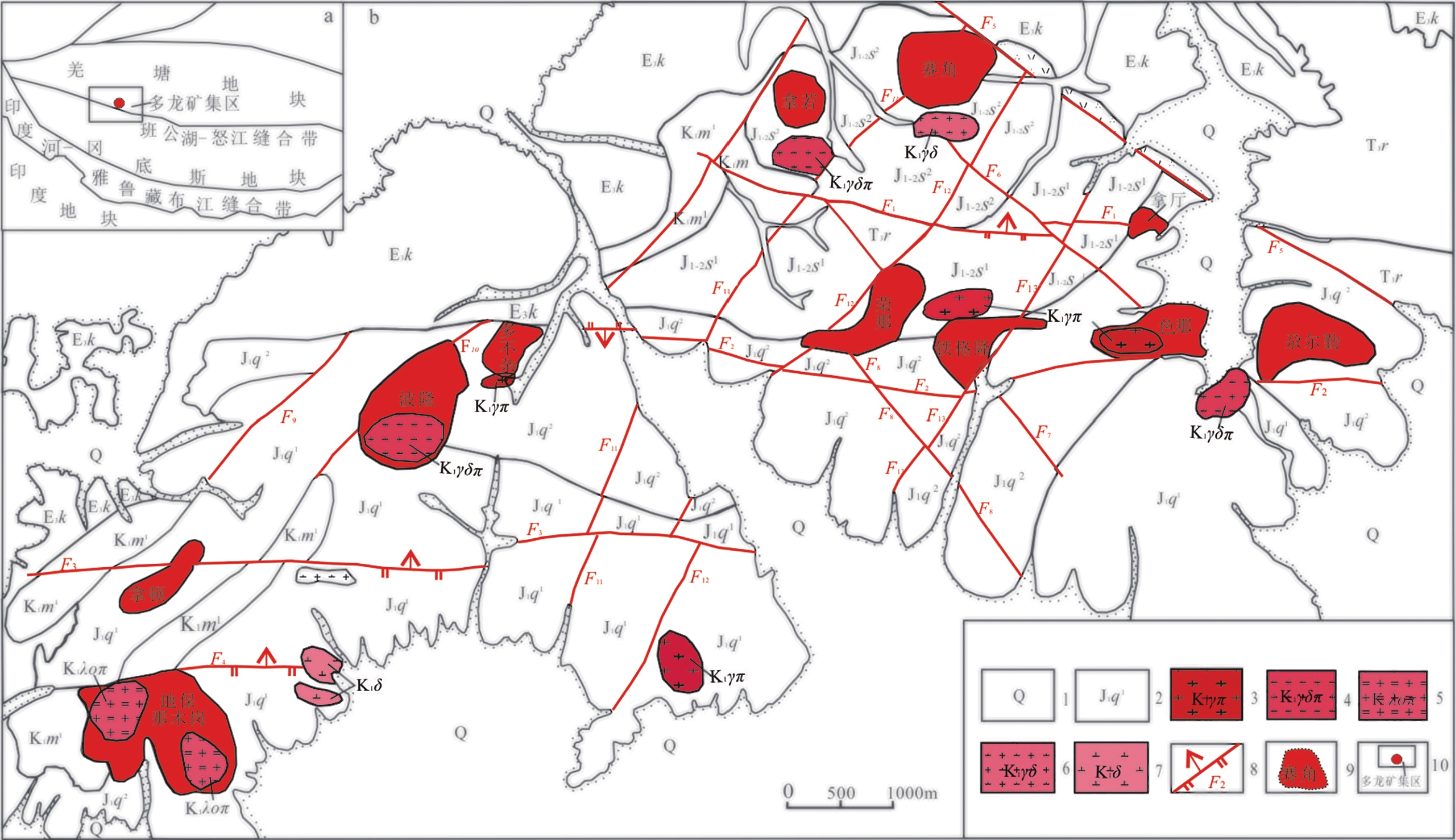
 下载:
下载:
